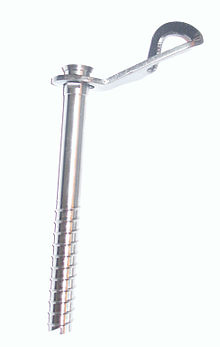Ice screw
Ice screws are used as a fixed point in ice climbing . Ice screws are pipe screws with very sharp, ground tips and a coarse thread on the outside. For weight reasons they are sometimes made of titanium , but mostly steel. Depending on the model, a small crank handle is attached to the safety eyelet, which makes it easier to screw the screw into the ice.
use
They are screwed into the ice with one hand and the blown, displaced ice is transported to the outside through the hollow ice screw. A carabiner for setting up a stand or an express set for laying an intermediate belay can be attached to the securing eye. When building a stand in the ice, two ice screws are generally connected to a sling using a triangle of forces. The angle of this triangle of forces should be as small as possible in order to reduce the forces that act on the ice. The distribution of force is optimal when the screws are arranged one above the other and 50 cm apart.
Strength tests by Black Diamond, a manufacturer of ice screws, have shown total strengths of the ice protection of up to 40 kN . The German Alpine Association has also examined the strength of ice screws and securing devices in the ice. There, strengths of the ice protection of up to 22 kN were measured in “good ice”. (The measurement setup could only show 22 kN as maximum force.) Expressed in old units, 22 kN correspond to approx. 2200 kp or approx. 4000 kp at 40 kN. Several bolts were torn out of the rock during the attempt and aluminum screw carabiners failed.
When screwing a - hollow - ice screw into compact ice, broken ice flows out of its opening protruding into the open. Since this current stops when the tip reaches a cavity or liquid water, the ice cover lying on a body of water can be tested for a certain minimum thickness.
history
During the first ascent of the northwest face of the Great Wiesbachhorn in the Glockner Group in 1924 Fritz Rigele and Willo Welzenbach overcame the ice bulge in the middle of the wall with the help of ice hooks that were used for the first time. In addition to the advantage of quick setting, a major disadvantage of the ice hooks was the need to knock them free almost completely in order to be able to pull them out of the ice again - once frozen. In a good 90 years the ice hooks (1 and 2), the Marwa screws (3), the ice screws of the 1970s (4) and the pipe ice hooks (5) became the ice screws of today (6), which Have the thread unscrewed again.
literature
- Chris Semmel, Florian Hellberg: Ice screws in glacier ice: Security worth screwing . In: DAV Panorama . No. 4 , 2008, p. 65–67 ( alpenverein.de [PDF; 329 kB ]).
Web links
Individual evidence
- ↑ http://www.expeditionsbergstieg.com/News/icherung-eisverbindungen.html (accessed on August 25, 2007).
- ↑ Chris Semmel, Dieter Stopper: Ice cold or hot? What do backups hold in ice falls? In: DAV Panorama 2/2005, Munich 2005 ( PDF ( Memento of the original from September 27, 2007 in the Internet Archive ) Info: The archive link has been inserted automatically and has not yet been checked. Please check the original and archive link according to the instructions and then remove this notice . ).
- ↑ John Dittli Photography: Ice Skating the High Sierra youtube.com, November 26, 2009, accessed October 29, 2019. - Video (6:10) Here: 0: 47-1: 21.
- ^ Fritz Rigele: 50 Years of Mountaineering - Experiences and Thoughts. Sport und Spiel Verlags- und Vertriebs-GmbH, Berlin-Wilmersdorf 1935, p. 220 f.
- ^ Wolfgang Pusch, Leo Baumgartner: Großglockner. 200 years of first ascent . 2nd Edition. Bergverlag Rother , Munich 2001, ISBN 3-7633-7509-0 .

